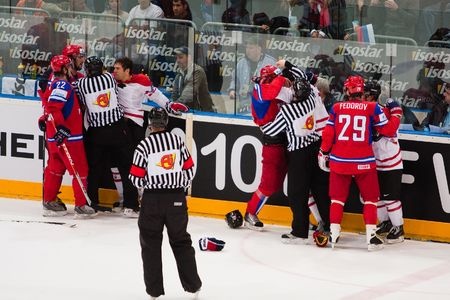Note that your final mark will not be saved in the system.
3.2.4.4 Violence in sport GapFill
You must fill all the gaps before clicking ‘Check Answers!’

Violence is inherent in sport, occurring both on the field of play between participants and in the stands among . It can be a reflection of passion, a consequence of aggression, or even a requirement for performance. Therefore, its causes are both situation- and sport-dependent. For example, you are far more likely to witness violent behaviour in contact team sports such as rugby and boxing than you are in non-contact individual sports such as tennis and golf. Likewise, violence is more likely to be expected in fixtures between rival teams in a cup final than it is in a preseason friendly match.
Causes of violence:
- Frustration – Psychological theories of aggression, such as the frustration–aggression hypothesis, can be used to explain player and spectator violence. It suggests that when there is a struggle to overcome obstacles in the way of achieving a goal, aggressive behaviour will ensue, often leading to a violent act. For example, if consecutive ball challenges go against a tennis player, they might throw their racket to the ground in a display of violence. Likewise, if a rugby player repeatedly drops the ball forward, then spectators might become frustrated and direct abuse towards the player.
- – Another cause might also be explained by a psychological theory, Bandura's theory of learning, where aggressive behaviour is copied primarily from significant others. For example, a young hockey player might observe an elite player's violent reaction to a foul, and emulate this during a youth game. Furthermore, violent behaviour on the pitch can stimulate violent behaviour from the spectators as they react to the incident.
- Fixture importance – The likelihood of violent behaviour is increased if two sets of spectators share a close . This is because there is the added passion and bragging rights at stake, giving the result of the fixture a huge personal significance. It may also stimulate violent actions on the pitch because of crowd reactions.
- Pre-emptive tactics – In some sports, violence might be planned as it is deemed a requirement to or purposely hurt an opponent. This can be applied to boxing where violence is necessary to improve the performer's chance of winning, and also football where a team might make a decision to injure an opponent to reduce their effectiveness in the game. Despite this obviously going against the code of , it is not surprising the lengths some choose to go to in order to ensure victory for their team.
- – This is a form of unprovoked spectator violence, which was treated as a weekend ritual in football in the 1980s. It is closely linked to social learning theory where others are more likely to go along with a group that displays violent behaviour – known as .
- – There has been a historical association between the pub and sport that extends back to the early twentieth century. It is not unusual for fans to meet in a pub before a game and dissect their team's performance 'over a pint' after the match has finished. This could result in a reduced control over one's behaviour and bring about violent behaviour that wouldn't normally be displayed at a level of sobriety.
Strategies to prevent violence:
- Rules and regulations – are responsible for enforcing rules on the pitch, with any serious breaches involving violence being immediately dealt with by a verbal warning, sin bin or sending off, with any further action being decided by the based on the severity of violent behaviour in question. This involves a detailed review of the incident, and a disciplinary panel if necessary, to ensure that the punishment is appropriate.
- – Violent spectators are at risk of receiving lifetime bans, fines and, in extreme circumstances, prosecution. Enforcing these consequences and making spectators aware could make them think twice about their behaviour. The sport’s governing body can also punish violent spectators by forcing their team to play behind closed doors. Coaches can enforce their own form of punishment, such as implementing a fining system or deciding to drop a player if they are not suspended from competition anyway.
- measures – These are enhanced to reduce spectator violence, usually by increasing CCTV coverage and by positioning additional police staff and stewards within and around the area of an event.